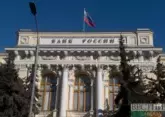The board of directors of Russia's Central Bank cut the key rate by 0.25 percentage points to 6.25% annually as inflation has slowed down faster than expected, the regulator said in a statement.
"Annual dynamics of the consumer price index fell to 3.5% in November from 3.8% in October 2019, and stood at about 3.4% as of December 9. Annual base inflation also contracted to 3.5% in November from 3.7% in October," the statement reads.
According to the regulator, Russia’s inflation will amount to 2.9–3.2% in 2019, and to 3.5–4.0% in 2020 after amounting to below 3% in the first quarter of the year, and stay close to 4% after that.
Disinflationary factors had a significant impact on inflation in November. Bumper crop and wider supply at some food markets kept the food prices low, while strengthening of the ruble restricts the growth prices for imports. Limited demand also restricts inflation. Russians’ inflationary expectations continued to contract in November staying relatively high, while pricing expectations of companies remained unchanged, PRIME cited the report as saying.
In the short term, disinflationary risks outweigh pro-inflationary risks due to the condition of internal and external demand.
Growth of Russia’s GDP may be closer to 1.3% in 2019 due to higher growth of GDP in July–September. It will gradually speed up to 2–3% in 2022, mainly due to the impact of national projects. Internal demand improved slightly in July–September and in October–December, and investment activity grew. Retail turnover also rose in October, as well as the industrial output.
The professor at the department of the stock market and investments at the Higher School of Economics, Alexander Abramov, speaking to Vestnik Kavkaza, noted that although some 0.25% cuts in the key rate were almost invisible to the economy, the annual 1.5% difference affected the Russian financial market quite seriously. "First of all, this key rate cut means a decrease in the population’s interest in deposits. The Central Bank’s policy also affected the attractiveness of government and corporate bonds in general," he pointed out.
"At the same time, a decrease in the key rate by 1.5% affected the accessibility of loans to a lesser extent. Partly, the banks decided to maintain a high internal margin. I think that next year, the Central Bank will continue to cut the key rate, but very carefully, including because it affects the attractiveness of government bonds, which may create some problems with filling the budget," Alexander Abramov expects.
The head of the department of stock markets and financial engineering of the Faculty of Finance and the Banking Business of RANEPA, former deputy chairman of the Central Bank of Russia Konstantin Korischenko, agreed with Abramov. "These 1.5% had an unambiguous effect on deposits. The banks have lowered their interest rates all year. It’s inconvenient for banks to lower it too fast, because they can lose customers. With regard to loans, the banks got involved in some race to lower rates, but also carefully," he said.
"At the same time, the cut in the key rate has not affected the economy as a whole. The fact is that the need for credit resources today is determined not so much by the rate, as by the ability of enterprises to use this money to finance their own business. As for the prospects, we can expect that in during 2020, the rate will be cut further, but not so massively in annual terms," Konstantin Korishchenko concluded.
The next meeting of the Board of Directors of the Central Bank, at which the key rate will be discussed, will be held on February 7, 2020.










